
This spring of karst origin, that was declared a geological monument in 1985, is situated in Biržai region, in Likėnai village. It gives start to the stream Smardonė that flows into the river Tatula. The pit of the spring consists of a sinkhole that is reminiscent of an oval funnel with a very sloping bottom. The cross diameters of the sinkhole are 15 and 17 meters. Loamy banks with a height of up to 1,5 m, that are covered with a green turf, rise above the water level of the spring. There are two stream pools with lots of whirlpools (especially during the spring melt) in the pit of this spring, with sludge deposits and rocks (boulders) on its bottom. These streams penetrate 1.5-3 m deep into the ground.
The water flows to Smardonė spring from the karst sedimentary rock layers (gypsum, dolomite, etc.). The water is slightly bitter, has a slight odour of sulphur hydrogen gas that is reminiscent of a rotten egg. This is where Smardonė spring draws its name from (in Lithuanian “smirda” means stinks).
Theodor von Grotthuss, the chemist who specialised in electrochemistry, was the first to perform analyses of the composition of the spring water and to announce their results in 1816. The spring water was formerly used for treatment, but it is no longer used for this purpose.